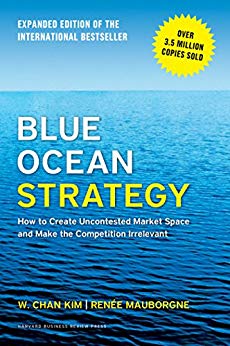

This article is an excerpt from the Shortform summary of "Blue Ocean Strategy" by W. Chan Kim and Renee Mauborgne. Shortform has the world's best summaries of books you should be reading.
Like this article? Sign up for a free trial here .
Are you looking for Blue Ocean Strategy quotes by Renée Mauborgne and W. Chan Kim? What are some of the most noteworthy passages worth revisiting?
In Blue Ocean Strategy, W. Chan Kim and Renée Mauborgne suggest that the answer to competitive problems is to create a “blue ocean.” A blue ocean is a brand-new market for an innovative idea, allowing your company to avoid competing with rivals—because it has no direct rivals.
Below is a selection of quotes with explanations to help you put them into context.
Blue Ocean Strategy
In Blue Ocean Strategy, INSEAD business professors W. Chan Kim and Renée Mauborgne argue that the solution to business growth and success is to operate in an uncontested market. They use the metaphor of a blue ocean to represent an uncontested market, and they contrast it with a red ocean, a marketplace where fierce competition has stained the water with the blood of the combatants.
The following Blue Ocean Strategy quotes highlight some of their key ideas:
“Blue ocean shift is a systematic process to move your organization from cutthroat markets with bloody competition—what we think of as red oceans full of sharks—to wide-open blue oceans, or new markets devoid of competition, in a way that brings your people along.”
Kim and Mauborgne assert that the key to a successful business is to create what they call a blue ocean: a brand-new market for an innovative idea, allowing your company to avoid competing with rivals—because it has no direct rivals. They contrast it with a “red ocean”, a marketplace where fierce competition has stained the water with the blood of the combatants. According to the authors, crowded markets and red ocean strategies tend to produce minimal profit margins, while blue ocean strategies lead to more profitable growth.
“Value innovation is the cornerstone of blue ocean strategy. We call it value innovation because instead of focusing on beating the competition, you focus on making the competition irrelevant by creating a leap in value for buyers and your company, thereby opening up new and uncontested market space. Value innovation places equal emphasis on value.”
Kim and Mauborgne argue that a blue ocean strategy starts with what they call “value innovation”—an innovation that makes your product so unique and superior to the competition (and thus more valuable to your customers) that you open up uncontested markets and leave your rivals behind. In this case, value is the benefit that your customers get for their money, while innovation is the uniqueness and originality of the benefit. To be effective, value and innovation are both required. By contrast:
- Value creation without innovation tends to mean incremental improvements. For instance, decreasing costs and prices by 2% can create a lot of value, but it doesn’t lead to a new market space and differentiation.
- Innovation without value creation tends to create unique high-tech products that nobody wants to buy.
Typically, this “blue ocean innovation” involves adding value by creating new features that buyers want, while cutting costs by reducing or eliminating features they don’t care as much about, resulting in a unique offering.
“The strategic price you set for your offering must not only attract buyers in large numbers but also help you to retain them.”
Kim and Mauborgne advise setting your price to maximize the number of buyers in your market. In other words, you want to select a price that will make your product attractive to as many potential customers as possible. The authors say that appealing to as many buyers as possible up front has several advantages over the common practice of starting with a premium price to attract early adopters and then gradually lowering prices to attract mainstream customers:
1. Often, appealing to the maximum number of buyers maximizes profits, because in many industries, fixed costs (one-time expenses associated with launching your product) are high and marginal costs (ongoing expenses associated with delivering each unit that you sell) are low, so attracting more buyers will subsidize your fixed costs while not costing you much more per customer. This is particularly true in software and R&D-heavy industries.
2. Many products benefit from network effects, where the value of the service scales with the number of users.
3. Strategic prices help earn a reputation for your brand immediately, making it harder for others to copy your strategy and turn your blue ocean into a red one.
“It is conventionally believed that companies can either create greater value to customers at a higher cost or create reasonable value at a lower cost. Here strategy is seen as making a choice between differentiation and low cost. In contrast, those that seek to create blue oceans pursue differentiation and low cost simultaneously.”
Blue ocean innovation is not a matter of merely raising or lowering value in order to raise or lower your costs. t’s easy to add premium features and offer a higher-value product at a higher price, or cut features to offer an economy version at a lower price, but that doesn’t require innovation. Instead, Kim and Mauborgne assert that you need a breakthrough that allows you to offer better value at lower cost. Instead, Kim and Mauborgne assert that you need a breakthrough that allows you to offer better value at lower cost.
To illustrate how a company can successfully implement a blue ocean strategy, Kim and Mauborgne discuss the Canadian company Cirque du Soleil (“Circus of the Sun”), which created a blue ocean for itself by redefining circus entertainment. They took some of the most popular types of circus acts, such as clowns and acrobatics, and wove these acts together with elements of theater into a coherent performance with a coherent storyline. At the same time, they eliminated traditional circus features like animal acts that were less important to customers and more costly to the circus. By doing so, they demonstrated the blue ocean innovation concept of focusing on what customers want and eliminating what they don’t.
———End of Preview———

Like what you just read? Read the rest of the world's best summary of "Blue Ocean Strategy" at Shortform . Learn the book's critical concepts in 20 minutes or less .
Here's what you'll find in our full Blue Ocean Strategy summary :
- What blue oceans are, and how you create one for your business
- Why some businesses succeed in creating blue oceans, and why others fail
- The red ocean traps you have to avoid if you want business growth






